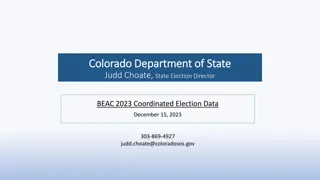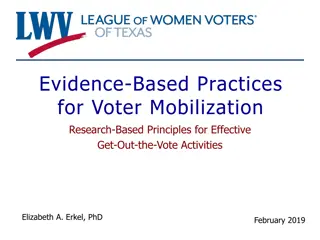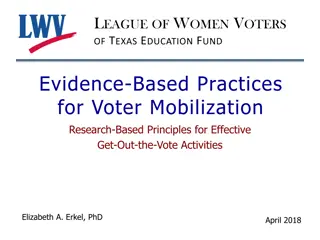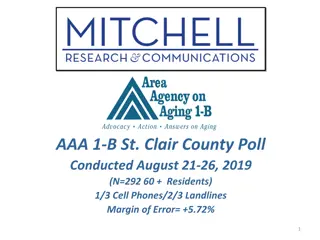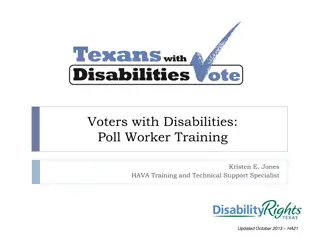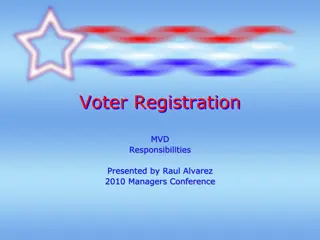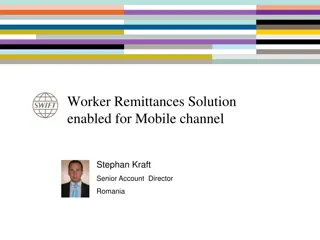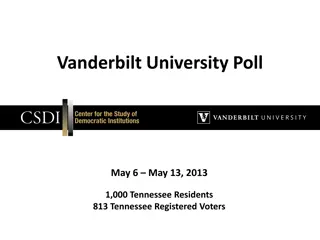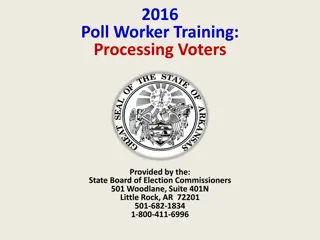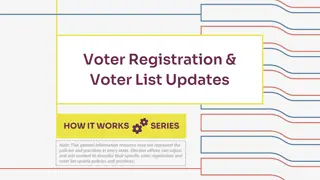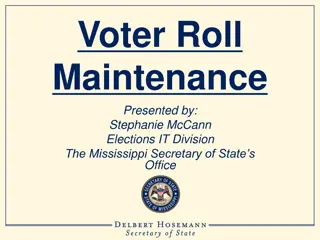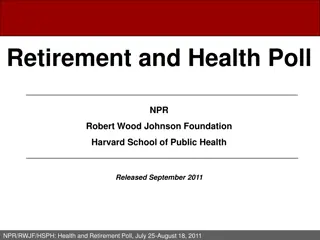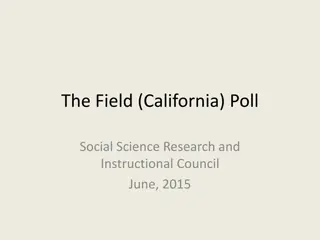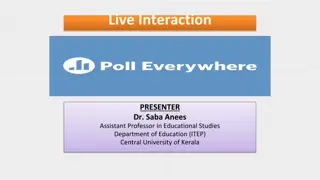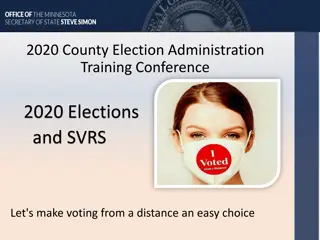Poll Worker Training Guidelines for Voter Processing
Training guidelines for poll workers provided by the State Board of Election Commissioners focus on key aspects such as handling voter eligibility, primary elections, voter identification, and steps for processing voters during voting hours. The guidelines emphasize not turning away any voter, handling primary election ballots neutrally, recording voter choices accurately, and following ID verification procedures diligently. Poll workers are instructed to follow specific steps for processing voters, including asking for identification, confirming voter information, recording ballot choices, and providing appropriate ballots. Poll workers are reminded of the importance of following election laws and ensuring a smooth voting process for all participants.
- Poll Worker Training
- Voter Processing
- Election Guidelines
- Voting Procedures
- State Board of Election Commissioners
Download Presentation

Please find below an Image/Link to download the presentation.
The content on the website is provided AS IS for your information and personal use only. It may not be sold, licensed, or shared on other websites without obtaining consent from the author. Download presentation by click this link. If you encounter any issues during the download, it is possible that the publisher has removed the file from their server.
E N D
Presentation Transcript
2016 Poll Worker Training: Processing Voters Provided by the: State Board of Election Commissioners 501 Woodlane, Suite 401N, Little Rock, AR 72201 1-800-411-6996 www.arkansas.gov/sbec info.sbec@sos.arkansas.gov
Emphasis for Todays Training NO VOTER TURNED AWAY Do not refuse anyone the right to vote. If you cannot determine a voter s eligibility, offer the voter a provisional ballot. PRIMARY ELECTIONS When processing a voter for the Primary Election, ask the voter which primary ballot do you want? Do not ask a voter which party do you belong to or are you a Democrat or Republican? Do not suggest to a voter which Primary Election he or she should vote in. You MUST indicate which ballot the voter received by marking D, R, or NPnext to the voter s name on the Precinct Voter Registration (PVR) List (aka the poll book). Do not allow someone to crossover vote in a Runoff Election. 2
Emphasis for Todays Training VOTER ID Poll workers are required by law to ASK every voter to provide ID. However, most voters DO NOT have to provide ID in order to vote a regular ballot. Only voters with a must show ID notation on the PVR list are required to provide ID; if these voters do not provide ID then they must be given a provisional ballot. 3
During Voting Hours This section is intended for poll workers who process voters and contains general information that all poll workers should familiarize themselves with. We ll talk about the steps for processing voters with emphasis on: Voter ID Recording voters ballot choices for Primary Elections Preventing Crossover voting 4
Processing Voters (pages 21-25 of training guide) Step 1: Ask the voter to state his/her name, address and date of birth Step 2: Confirm information to the PVR List Step 3: Ask voter to provide ID. Step 4: Check PVR List for a must show id notation (flagged voter) and indicate on PVR list whether or not the voter provided ID Step 5: Ask the voter to state his ballot choice. Step 6: Primary Elections Only: Record the voter s ballot choice (D, R, or NP) on the PVR list. Step 7: Runoff Elections Only: Refer to the D, R, or NP notations on the PVR List to determine which Runoff election the voter is eligible for Step 8: Ask the voter to sign PVR List Step 9: Record voters name on the List of Voters form Step 10: Give the voter a ballot (paper, electronic, or provisional) 5
Voter ID Emphasis (steps 3-4) Valid forms of ID include: a current and valid photo ID or a copy of a current utility bill, bank statement, government check, paycheck, or other government document that shows the name and address of the voter. Note:Poll workers are required by law to ASK every voter to provide ID. However, most voters DO NOT have to provide ID in order to vote a regular ballot. Only voters with a must show ID notation on the PVR list are required to provide ID; if these voters do not provide ID then they must be given a provisional ballot. These procedures are specifically addressed in the next steps. 6
Voter ID Emphasis (steps 3-4) Poll workers should not ask for a specific form of ID such as a Drivers License. Just ask generically for ID! If a voter does not show identification then the poll worker indicates this on the poll book & the voter votes a REGULAR ballot Requirement for certain FLAGGED VOTERS Voters with a MUST SHOW ID notation on the PVR list must present current/valid identification or else vote a PROVISIONAL ballot Usually first-time voters who register by mail & don t provide ID w/ VR 7
Reminders on ID (steps 3-4) DO NOT turn away ANY voter who fails to provide ID; a voter should at least be provided a provisional ballot. Poll workers must ASK every voter to provide ID; Providing ID is optional for the voter DO NOT demand a driver s license. If you are using an electronic poll book with scanning capability, you may explain that an AR driver s license will speed up the process for the voter. If a voter provides a valid form of ID, do not ask for a different form. unless the voter has a must show id notation on the PVR list or swiping 8
Processing Voters for March Primary Election (steps 5-6) For the 2016 Primary, ballot choices include: ADemocratic ballot containing Democratic party candidates, nonpartisan judicial candidates, prosecutorial candidates, and any special election issues A Republican ballot containing Republican party candidates, nonpartisan judicial candidates, prosecutorial candidates, and any special election issues A Nonpartisan ballot containing nonpartisan judicial candidates, prosecutorial candidates, and any special election issues 10
Processing Voters for March Primary Election (steps 5-6) Ask the voter which party primary he/she wishes to vote in. Don t ask which party he/she belongs to, etc. Markthe voter s ballot choice (D, R, NP) on the PVR List. This is ESSENTIAL information that must be recorded for EVERY voter to prevent crossover voting in a runoff election! 11
Crossover Voting is a Crime Voters: Poll Workers: It is a misdemeanor, punishable by up to one year incarceration and a fine of up to $2,500, for a person to vote in the preferential primary of onepolitical party and the general primary(runoff) of another. It is a felony, punishable by up to six years incarceration and a fine of up to $10,000 for a poll worker to knowingly permit a person to vote other than his or her legal ballot or fraudulently permit a person to vote illegally. https://bugs.freenas.org/attachments/3315/monopoly_jail_xlarge.jpeg Example: A voter who voted in the Republican primary election in March cannot then vote in the Democratic party s Runoff election. 12
Processing Voters for March Runoff Elections (step 7) Refer to the notations (D, R, NP) on the PVR List No Notation - Ask voter in which primary they voted Voter did not Vote in the Primary or voted NP: Voter may vote in either the Democratic or Republican runoff No Cross-Over Voting 14
Fail-Safe Voting pages (21-22 of training guide) Name provided differs with PVR List DOB provided differs with PVR List Address provided differs with PVR List Address is not within precinct Voter registration cannot be verified PVR notations ABS or EA 15
Name or DOB Discrepancy Name Provided Differs with PVR List: Ask voter to complete a Voter Registration Application form to update county records Give voter a regular ballot If the voter refuses to complete the VR app, give them a provisional ballot Birth Date Provided Differs with PVR List: Request additional ID Ask voter to complete a Voter Registration Application form to update county records Give voter a regularballot If additional ID is not provided, give voter a provisional ballot 16
Address Discrepancy Inside of Precinct Address Provided Differs with PVR List: Contact County Clerk s office to verify the voter s precinct and correct poll If the Address is ConfirmedWithin the Precinct: Ask voter to complete a Voter Registration Application form to update county records; and Give voter a regular ballot If the voter refuses to complete the VR app, give them a provisional ballot http://img.docstoccdn.com/thumb/orig/42336799.png 17
Address Discrepancy Outside of Precinct If the Address is notWithin the Precinct: Complete Change in Polling Site Authorization form Ask voter to complete a Voter Registration Application form to update county records Direct voter to correct poll Instruct voter to present Change in Polling Site Authorization form at new poll Voter votes a regular ballot at his or her new and correct poll 18
Other Issues Voter Refuses to go to Correct Poll: Voter must complete Eligibility Affirmation located on the Provisional Voter Envelope Voter votes a provisional ballot Voter s Name is not on PVR List: Contact County Clerk s office to verify voter s registration status, precinct, and correct poll Follow separate procedures discussed previously for when: Address is confirmed within precinct OR Address is not within precinct 19
Other Issues Voter Registration Cannot be Verified but the voter contends to be registered in the precinct and eligible to vote: Have the voter complete Eligibility Affirmation located on the Provisional Voter Envelope; and Allow the voter to vote a provisional ballot ABS Notation on the PVR List: Means that an absentee ballot was delivered to the voter Voter votes a provisional ballot EA Notation on the PVR List: Means that the voter may have already voted early Voter votes a provisional ballot 20
Lets Review Which of the following voters should be asked by a poll worker to provide ID? a) All voters b) Only voters that the poll workers do not know c) Only voters with a MUST SHOW ID notation on the Precinct Voter Registration (PVR) List 22
A voter who does not provide ID and who is not flagged with a MUST SHOW ID notation should: a) Not be allowed to vote b) Be allowed to vote only a PROVISIONAL ballot c) Be allowed to vote a REGULAR ballot, after the poll worker writes No ID on the PVR List Remember: Only flagged voters are required to provide ID or else vote a provisional ballot. 23
In a primary election, the voter must state: a) Whether he or she is a Democrat or Republican b) Whether he or she is an Independent c) In which party s primary or other election he or she wants to vote 24
Before giving a paper ballot to the voter, the poll worker must initial: a) The back of the ballot b) The front of the ballot c) No part of the ballot 25
If a voters current address is different than the address listed on the precinct voter registration list, the poll worker should: a) Call the county clerk to determine the voter s correct polling site b) Give the voter a PROVISIONAL ballot c) Let the voter cast a REGULAR ballot if the county clerk determines that the address is within the precinct and the voter updates a voter registration application form. d) Both a) and c) 26
If a voters current address is not within the voting precinct, the poll worker should: a) Call the county clerk to determine the voter s correct polling site and send the voter there to vote b) Give the voter a PROVISIONAL ballot c) Let the voter cast a REGULAR ballot 27
If a voters name is not listed on the PVR List and the county clerk cannot verify the voter s registration, the poll worker must: a) Allow the voter to cast a REGULAR ballot b) Inform the voter that he or she cannot vote c) Allow the voter to cast a PROVISIONAL ballot 28
For Primary Runoff Elections, poll workers must refer to the D , R , or NP notation on the PVR List to: a) Ensure that voter is not attempting to crossover vote b) Determine that the voter is eligible to vote the ballot that he or she is requesting c) Determine the voter s party affiliation d) Both a and b 29
Dont Forget these Emphasis Items NO VOTER TURNED AWAY Do not refuse anyone the right to vote. If you cannot determine a voter s eligibility, offer the voter a provisional ballot. PRIMARY ELECTIONS When processing a voter for the Primary Election, ask the voter which primary ballot do you want? Do not ask a voter which party do you belong to or are you a Democrat or Republican? Do not suggest to a voter which Primary Election he or she should vote in. You MUST indicate which ballot EVERY voter received by marking D, R, or NPnext to the voter s name on the Precinct Voter Registration (PVR) List (aka the poll book). Do not allow someone to crossover vote in a Runoff Election. 30
Dont Forget these Emphasis Items VOTER ID Poll workers are required by law to ASK every voter to provide ID. However, most voters DO NOT have to provide ID in order to vote a regular ballot. Only voters with a must show ID notation on the PVR list are required to provide ID; if these voters do not provide ID then they must be given a provisional ballot. 31




